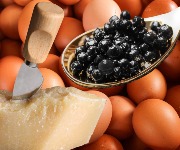What's so special about salt marsh lamb?
The French have prized pré-salé lamb for over a century; now British salt marsh lamb is winning us over.
As the name implies, salt marsh lambs graze on land regularly covered by the sea – at least twice yearly – where the pasture contains salt-tolerant plants (halophytes) such as samphire, sea purslane, and sparta grasses which contain minerals that influence the flavour.
“Because they roam and use their muscles, salt marsh lambs tend to be leaner and the meat looks darker and redder, a bit like game,” says Niovi Ducker of the Cumbrian Holker Hall Estate, where lambs are free to roam the salt marsh. And salt marsh lambs will never be anything but lean, explains Stuart Lawson of Bank End Farm near Lancaster: “Grazing isn’t as easy for lambs on a salt marsh. The grass is very short, so that’s why you don’t get over-fat lambs.”
Strangely, until relatively recently the meat was rarely sold as salt marsh lamb, and was instead lumped in with more standard fare. But thanks to farmers’ markets and e-commerce, as well as support from chefs like Gordon Ramsay and Nigel Haworth, salt marsh lamb is starting to fill a premium niche.
What’s different about the flavour?
“Everybody thinks it will be salty, but it’s really the opposite – a sweeter meat that’s denser too. And when it’s cooked you don’t get that fatty smell that ‘normal’ lamb has - it even smells sweeter,” Niovi tells me. Vicky Williams of Gower Salt Marsh Lambalso loves its “greater depth of flavour”, and also identifies the sweetness.
Where is it reared?
Islands have no shortage of marshland pasture. The Cumbrian and Lancashire shores of Morecambe Bay have some noted suppliers, and theGower Peninsular in South Wales has long had a reputation for its salt marsh lamb, as has Anglesey. Romney Marsh that spreads over swathes of Kent and East Sussex is another established source, though as so often with the finest produce the French have traditionally snaffled much from there.
Stuart Lawson’s Lancashire farm with 450 acres of salt marsh supporting 500 lambs is perhaps typical of this marginal grazing, reclaimed by the sea for a few days every month. “The high tides can last on the salt marshes from five days to a week,” he says. “So they’re inland for a week then back out for a month.” With fertiliser-free grass, plus salt keeping tics down, it’s largely chemical free too.
Cooks and cooking
Elizabeth David somewhat typically lauded pré-salé lamb from the Cotentin, but Rick Stein is more patriotic. In his Food Heroes, Stein offers a quickly-roasted rack of Welsh salt marsh lamb with a garlicky stew of peas and flageolets, though he worries that we are becoming averse to such meats which have deep flavour.
Stuart Lawson’s wife Caroline (pictured left) suggests serving roasts and chops with the samphire that the lambs eat, and as a less fatty meat it also lends itself to stews, ragouts and Navarins.
If you’ve tried it, what did you think? Talk to us in the comments box below...
Some other links you may enjoy
Most Recent
Comments
Be the first to comment
Do you want to comment on this article? You need to be signed in for this feature








